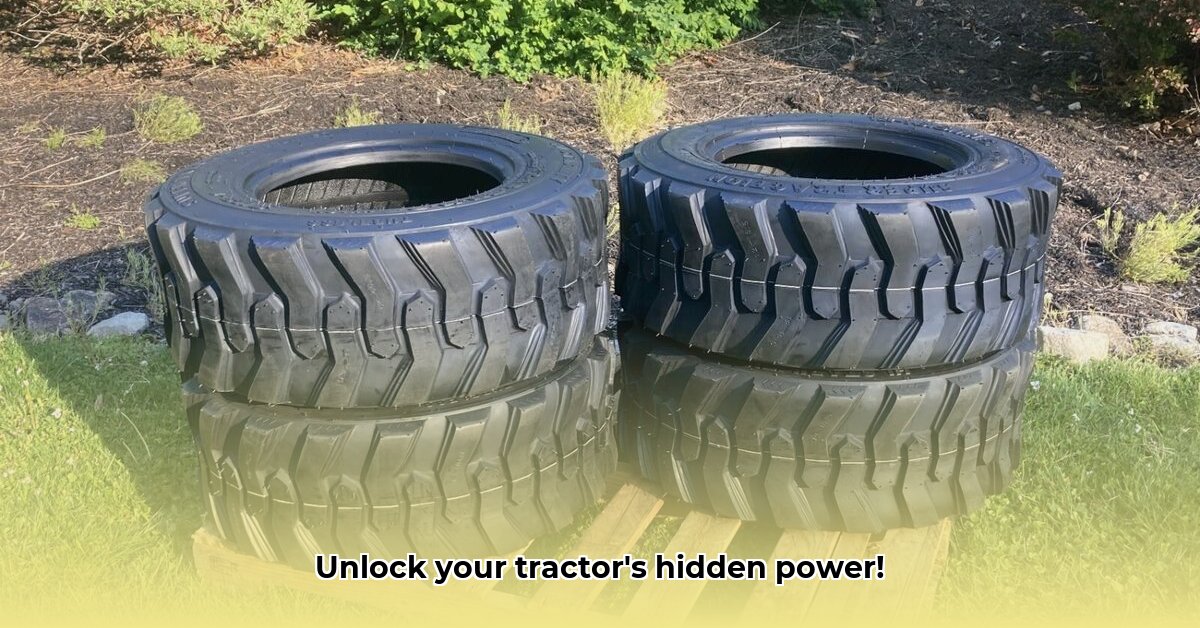
Choosing the right tractor tires is a critical decision for farmers, impacting operational efficiency, crop yields, and environmental sustainability. This guide focuses on 12-16.5 tractor tires, providing insights into maximizing performance and minimizing environmental impact. We'll explore performance metrics, sustainable practices, and the future of eco-friendly tire technology. For more information on other tractor tire sizes, check out this helpful resource: tractor tire sizes.
Understanding 12-16.5 Tractor Tire Performance
The performance of your 12-16.5 tractor tires directly correlates with your farm's overall efficiency. Factors like soil type, operating conditions, and tire construction significantly influence traction, fuel consumption, and soil compaction. For instance, sandy soils require different tread patterns compared to heavy clay soils. Deep tread patterns offer excellent grip in wet conditions but may cause unnecessary slippage on dry land. Conversely, shallow treads are more suitable for dry conditions but may lack grip in wet or muddy fields.
Selecting the appropriate tire size and construction for your tractor and its intended tasks is crucial. Larger diameter tires generally provide better flotation, reducing soil compaction, while the correct tire profile impacts ride quality and stability. Choosing a radial tire offers better fuel efficiency and longer lifespan than a bias-ply tire, influencing environmental impact, and reducing long-term costs.
Carlisle Trac Chief 12-16.5: A Case Study
The Carlisle Trac Chief 12-16.5 tire serves as a useful example. Its robust construction, aggressive tread pattern, and flat profile contribute to excellent traction and stability. This translates to better control, reduced slippage, and potentially lower fuel consumption. However, information regarding its entire life-cycle environmental impact remains limited, highlighting a broader need for data on agricultural tire sustainability.
"While the Trac Chief offers excellent performance, we need more comprehensive data on its environmental footprint across its entire lifecycle," explains Dr. Emily Carter, Agricultural Engineering Professor at Cornell University. "This includes manufacturing, transportation, use, and disposal."
Sustainability in Agricultural Tire Selection
Minimizing the environmental impact of your farming practices is paramount. While high-performance contributes to efficiency, its long-term environmental impact requires careful consideration. Current data on the full life cycle environmental footprint of many agricultural tires is scarce. This lack of information hinders efforts to promote truly sustainable farming practices.
"The industry needs to prioritize research into the full environmental impact of tire production and disposal," emphasizes Dr. Carter. "This includes considering the raw materials, manufacturing processes, tire longevity, and recycling potential."
Enhancing Tire Lifespan: Practical Steps for Sustainable Farming
Extending the life of your tires is a straightforward way to reduce both environmental impact and operational costs. Implementing these best practices can significantly increase tire longevity:
Regular Inflation Checks: Maintain proper tire pressure according to manufacturer recommendations and your soil conditions. This prevents underinflation-induced soil compaction and overinflation-caused tire damage. (Use a reliable pressure gauge.)
Tire Rotation: Rotate tires regularly to ensure even wear, maximizing their lifespan and minimizing uneven wear patterns.
Avoid Hard Surfaces: Minimize driving on hard surfaces whenever possible, reducing unnecessary wear and tear.
Regular Inspections: Regularly inspect tires for any damage (cuts, punctures, excessive wear), addressing issues promptly to prevent further problems.
Quantifiable Fact: Proper tire maintenance can increase tire lifespan by up to 25%, leading to significant cost savings.
The Future of Sustainable Tire Technology
The agricultural tire industry is actively pursuing more environmentally friendly options. Research focuses on developing bio-based materials for tire construction, improving manufacturing processes, and developing advanced recycling techniques.
"We're seeing increased interest in recycled rubber and other sustainable materials in tire manufacturing," notes Dr. Mark Olsen, Materials Scientist at the USDA. "This, combined with smart sensor technologies, promises to revolutionize tire management and minimize waste."
Actionable Steps for Sustainable Tire Management
Assess Soil Conditions: Determine your soil type and environmental conditions to select tires with the appropriate tread depth and construction.
Consult with Experts: Partner with agricultural equipment suppliers to receive personalized advice on tire selection based on your specific needs and operating conditions.
Prioritize Proper Inflation: Maintain correct tire inflation pressure consistently.
Implement Regular Inspections: Conduct routine inspections to identify and address issues promptly.
Explore Recycling Options: Inquire about locally available recycling programs for used tires.
Key Considerations for Sustainable Tire Selection
Soil Compaction: Minimize soil compaction by selecting appropriate tire sizes and maintaining correct inflation pressure.
Fuel Efficiency: Optimize fuel efficiency through tire selection and proper maintenance.
Tire Lifespan: Extend tire lifespan through regular maintenance and proper operating practices.
Sustainable Manufacturing: Support manufacturers committed to sustainable manufacturing practices.
Tire Recycling: Explore responsible end-of-life tire management solutions.
By implementing these strategies, farmers can significantly enhance the performance of their 12-16.5 tractor tires while promoting sustainable farming practices and reducing their environmental footprint. Remember that ongoing research and technological advancements consistently refine our understanding of agricultural tire technology. Staying informed will help in making responsible choices for your farm and the environment.